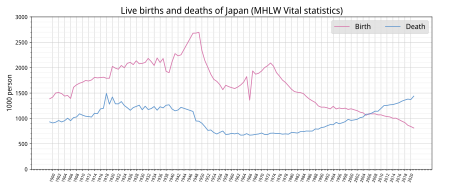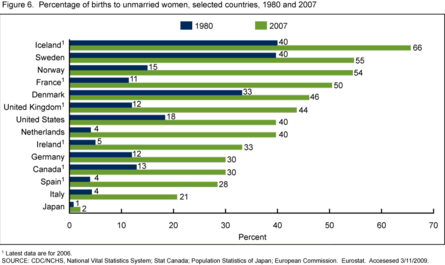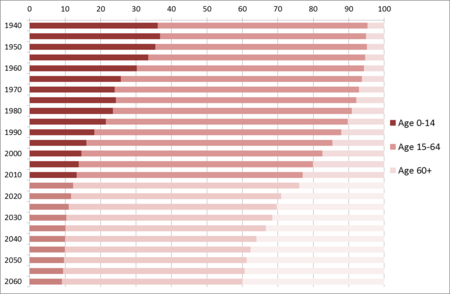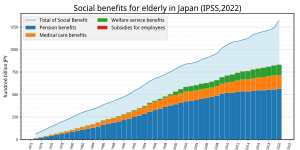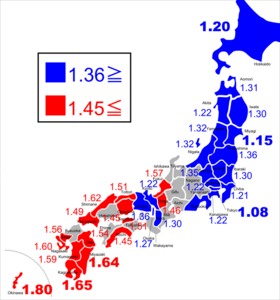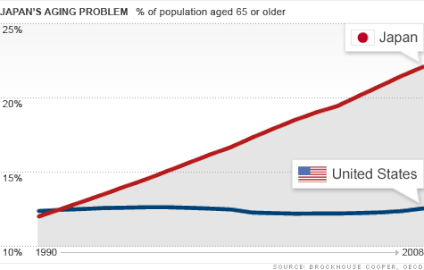
The demographics of Japan include Japanese population, birth and death rates, age distribution, population density, ethnicity, education level, healthcare system of the populace, economic status, religious affiliations, and other aspects regarding the population. According to the United Nations, the population of Japan was roughly 124.9 million people, which peaked at 128.1 million people in 2010. It the 6th-most populous country in Asia, and the 11th-most populous country in the world.

Demographic features of the population of South Korea include population density, ethnicity, education level, health of the populace, economic status, religious affiliations, and other aspects of the population. The common language and especially race are viewed as important elements by South Koreans in terms of identity, more than citizenship.

Birth rate, also known as natality, is the total number of live human births per 1,000 population for a given period divided by the length of the period in years. The number of live births is normally taken from a universal registration system for births; population counts from a census, and estimation through specialized demographic techniques. The birth rate is used to calculate population growth. The estimated average population may be taken as the mid-year population.

The dependency ratio is an age-population ratio of those typically not in the labor force and those typically in the labor force. It is used to measure the pressure on the productive population.

The Total Fertility Rate (TFR) of a population is the average number of children that are born to a woman over her lifetime if:
- they were to experience the exact current age-specific fertility rates (ASFRs) through their lifetime
- and they were to live from birth until the end of their reproductive life.

Sub-replacement fertility is a total fertility rate (TFR) that leads to each new generation being less populous than the older, previous one in a given area. The United Nations Population Division defines sub-replacement fertility as any rate below approximately 2.1 children born per woman of childbearing age, but the threshold can be as high as 3.4 in some developing countries because of higher mortality rates. Taken globally, the total fertility rate at replacement was 2.33 children per woman in 2003. This can be "translated" as 2 children per woman to replace the parents, plus a "third of a child" to make up for the higher probability of males born and mortality prior to the end of a person's fertile life. In 2020, the global average fertility rate was around 2.4 children born per woman.
Population decline, also known as depopulation, is a reduction in a human population size. Throughout history, Earth's total human population has continued to grow; however, current projections suggest that this long-term trend of steady population growth may be coming to an end.

Population ageing is an increasing median age in a population because of declining fertility rates and rising life expectancy. Most countries have rising life expectancy and an ageing population, trends that emerged first in developed countries but are now seen in virtually all developing countries. That is the case for every country in the world except the 18 countries designated as "demographic outliers" by the United Nations. The aged population is currently at its highest level in human history. The UN predicts the rate of population ageing in the 21st century will exceed that of the previous century. The number of people aged 60 years and over has tripled since 1950 and reached 600 million in 2000 and surpassed 700 million in 2006. It is projected that the combined senior and geriatric population will reach 2.1 billion by 2050. Countries vary significantly in terms of the degree and pace of ageing, and the UN expects populations that began ageing later will have less time to adapt to its implications.

A population pyramid or "age-sex pyramid" is a graphical illustration of the distribution of a population by age groups and sex; it typically takes the shape of a pyramid when the population is growing. Males are usually shown on the left and females on the right, and they may be measured in absolute numbers or as a percentage of the total population. The pyramid can be used to visualize the age of a particular population. It is also used in ecology to determine the overall age distribution of a population; an indication of the reproductive capabilities and likelihood of the continuation of a species. Number of people per unit area of land is called population density.
This article focuses on the situation of elderly people in Japan and the recent changes in society.
Demographic dividend, as defined by the United Nations Population Fund (UNFPA), is "the economic growth potential that can result from shifts in a population’s age structure, mainly when the share of the working-age population is larger than the non-working-age share of the population ". In other words, it is "a boost in economic productivity that occurs when there are growing numbers of people in the workforce relative to the number of dependents". UNFPA stated that "a country with both increasing numbers of young people and declining fertility has the potential to reap a demographic dividend."

The population of Taiwan is approximately 23.35 million as of April 2023.

The ageing of Europe, also known as the greying of Europe, is a demographic phenomenon in Europe characterised by a decrease in fertility, a decrease in mortality rate, and a higher life expectancy among European populations. Low birth rates and higher life expectancy contribute to the transformation of Europe's population pyramid shape. The most significant change is the transition towards a much older population structure, resulting in a decrease in the proportion of the working age while the number of the retired population increases. The total number of the older population is projected to increase greatly within the coming decades, with rising proportions of the post-war baby-boom generations reaching retirement. This will cause a high burden on the working age population as they provide for the increasing number of the older population.

Family policy in the country of Japan refers to government measures that attempt to increase the national birthrate in order to address Japan's declining population. It is speculated that leading causes of Japan's declining birthrate include the institutional and social challenges Japanese women face when expected to care for children while simultaneously working the long hours expected of Japanese workers. Japanese family policy measures therefore seek to make childcare easier for new parents.

Australia has an ageing demographic. The proportion of the Australian population aged 65 and over was 15% in 2017, a trend which is expected to continue to grow. It is estimated that by 2057 older people will account for 22% of the Australian population which translates to 8.8 million people. This increase in elderly population is due to what is known as The Australian Baby Boom. This period refers to the post-war era in which total fertility rates (TFR) were approximately 3.0, resulting in 4.19 million births recorded. This number exceeded the number of births in Australia from the previous 20 years in which there were 1.63 million births, and the proceeding 20 years in when 2.56 million births were recorded. The baby boom children will be celebrating their 65th birthday between 2011 and 2030, the age which is referred to as elderly.
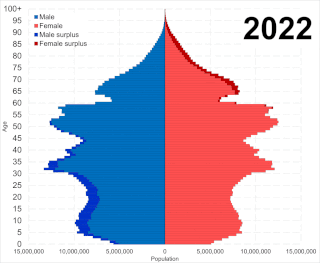
China's population is aging faster than almost all other countries in modern history. In 2050, the proportion of Chinese over retirement age will become 39 percent of the total population according to projections. China is rapidly aging at an earlier stage of its development than other countries. Current demographic trends could hinder economic growth and create challenging social issues in China.

In South Korea, aging refers to an increase in the proportion of senior citizens to the total population. The term "senior citizens" include those aged 65 or older. According to Article 3 no.1 of the Framework Act on Low Birthrate of an Aging Society, the term "aging population" refers to the increasing proportion of elderly people in the entire population.

In recent decades, the fertility rate of the United States has declined below replacement level, prompting projections of an aging population and workforce, as is already happening elsewhere in the developed world and some developing countries. The decline has been most noticeable since after the Great Recession of the late 2000s. Nevertheless, the rate of aging in the United States remains slower than that seen in many other countries, including some developing ones, giving the nation a significant competitive advantage. Unintentional pregnancies have become less common; in particular, teenage pregnancies have dropped to record lows.
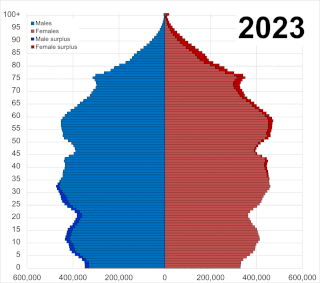
The population of the United Kingdom is getting increasingly older, due to longer life expectancy and a sub-replacement fertility rate for little under 50 years. The society is expected to change as a result culturally and economically. By 2050, 1 in every 4 people is expected to be above the age of 65 and this will be more extreme in certain areas of the country.
Generation Alpha is a social cohort born between the early 2010s and mid 2020s. The birth years of Generation Alpha have seen a decline in birth rates, especially in the developed world.



